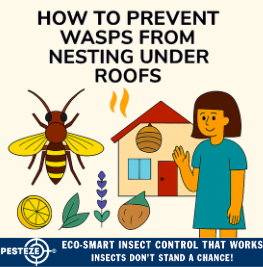HOW TO PREVENT WASPS FROM NESTING UNDER ROOFS

HOW TO PREVENT WASPS FROM NESTING UNDER ROOFS
SUMMARY
Wasps often build nests under roofs, eaves, and overhangs, creating safety risks for households. These nests can grow quickly and make outdoor areas uncomfortable. By combining preventive maintenance, natural repellents, and deterrents, you can stop wasps from nesting under roofs and keep your home safer and more enjoyable year-round.
FEATURES
-
Seal Cracks and Openings – Close gaps around eaves, vents, and siding where wasps may enter.
-
Apply Natural Repellents – Peppermint oil, clove, and citronella deter wasps from building nests.
-
Use Decoy Nests – Hanging artificial nests discourages wasps from settling nearby.
-
Maintain Regular Roof Inspections – Check for early signs of wasp activity to stop nests from forming.
-
Reduce Attractants – Keep trash sealed and food sources away from rooflines.
-
Trim Vegetation Near Roofs – Prevent overhanging branches that give wasps easy access.
GUIDE DESCRIPTION
Wasps are resourceful builders, often choosing sheltered spaces under roofs, eaves, and overhangs to construct their nests. Once established, these nests can house large colonies, making it dangerous to use outdoor areas nearby. Preventing wasps from nesting under roofs requires a combination of proactive home maintenance and natural deterrents.
The first step is to seal cracks and openings. Wasps often slip through small gaps near vents, fascia boards, or siding. Using caulk, weatherstripping, or fine mesh screens over vents reduces possible entry points. A tightly sealed home is far less inviting for nest building.
Next, apply natural repellents. Wasps dislike strong scents like peppermint, clove, and citronella. Mixing these essential oils with water and spraying them under eaves and roof edges can deter wasps from starting construction. Reapplying regularly during spring and summer ensures continued protection.
Another effective strategy is to hang decoy nests. Wasps are territorial and typically avoid building nests near another colony. Artificial nests, available in garden stores or easily crafted, can discourage wasps from choosing your roof as their home.
Routine roof inspections are also key. In early spring, when wasps first begin building, check under eaves and corners for small paper-like beginnings of nests. Removing these early with a broom or stick is far safer than tackling a full colony later.
Reducing attractants is equally important. Wasps are drawn to open food, sugary drinks, and accessible trash. Keeping garbage bins sealed and away from rooflines minimizes their interest in nesting nearby.
Finally, trim nearby vegetation. Overhanging tree branches and thick shrubs close to roofs give wasps easy access and added shelter. Regular pruning not only improves curb appeal but also reduces wasp activity.
By sealing entry points, using natural repellents, maintaining cleanliness, and performing regular inspections, you can prevent wasps from nesting under your roof. These proactive steps help protect your home and allow you to enjoy outdoor spaces without worry.
- Shashank Rongali


Comments 0